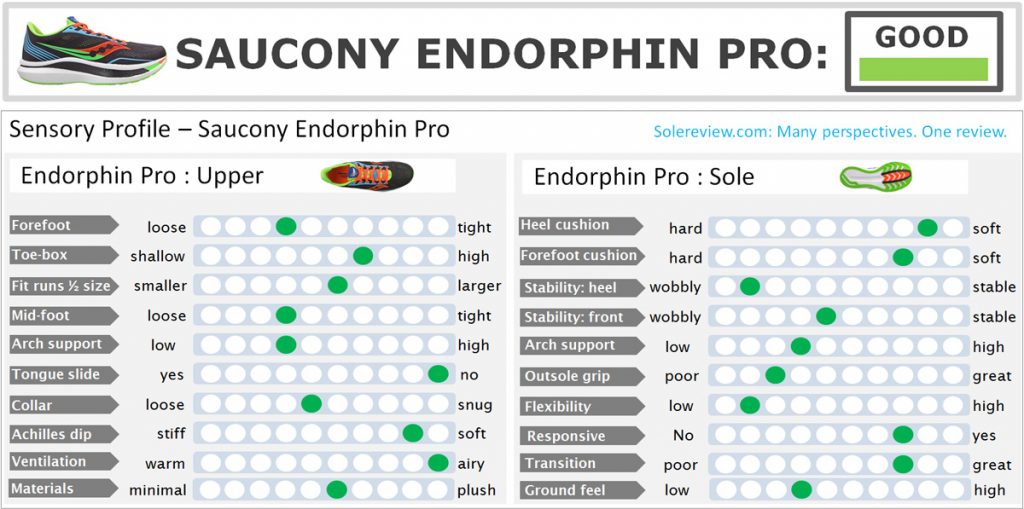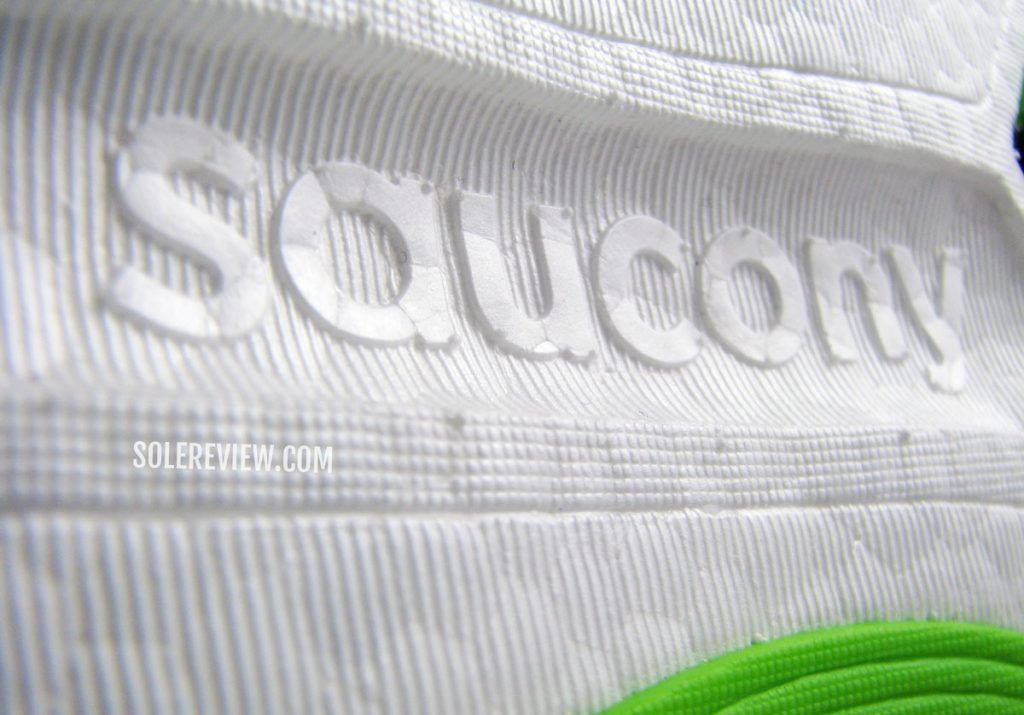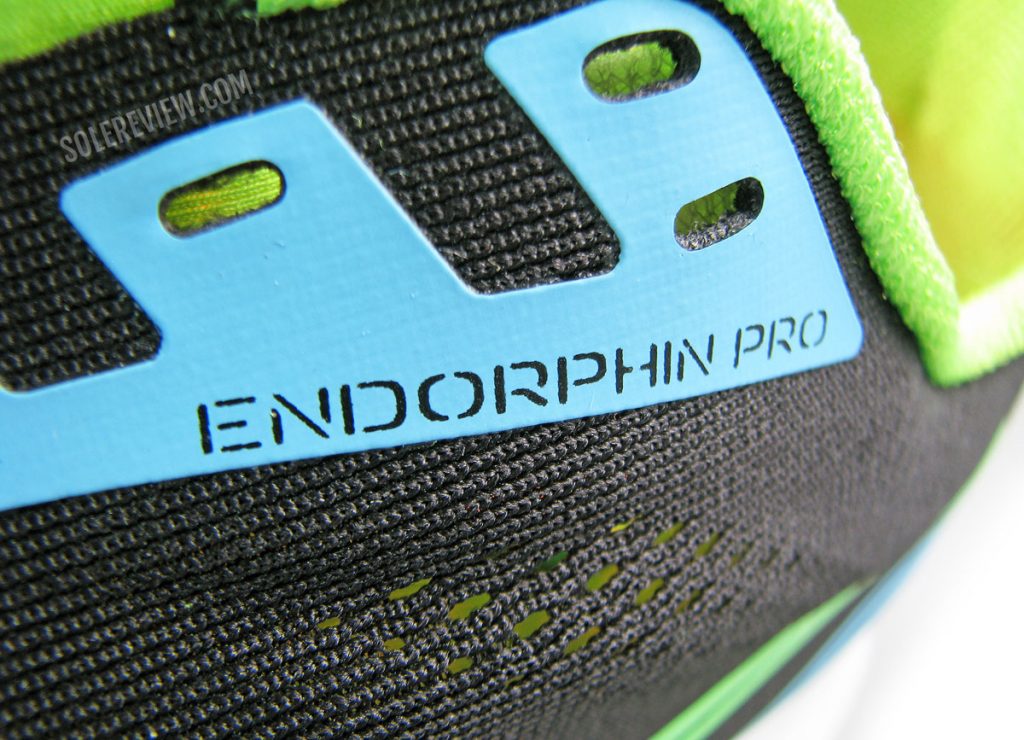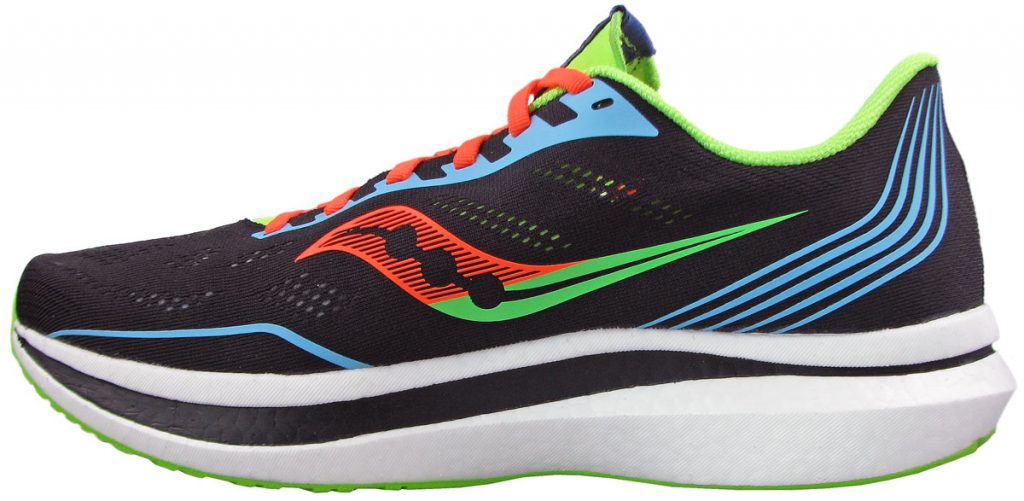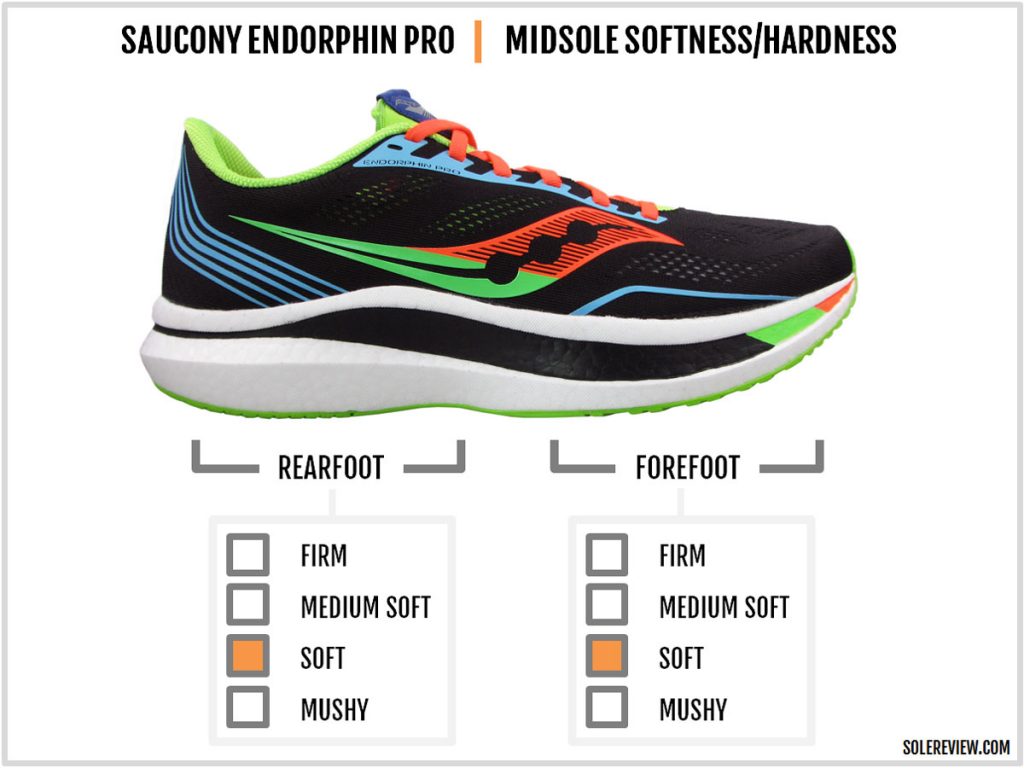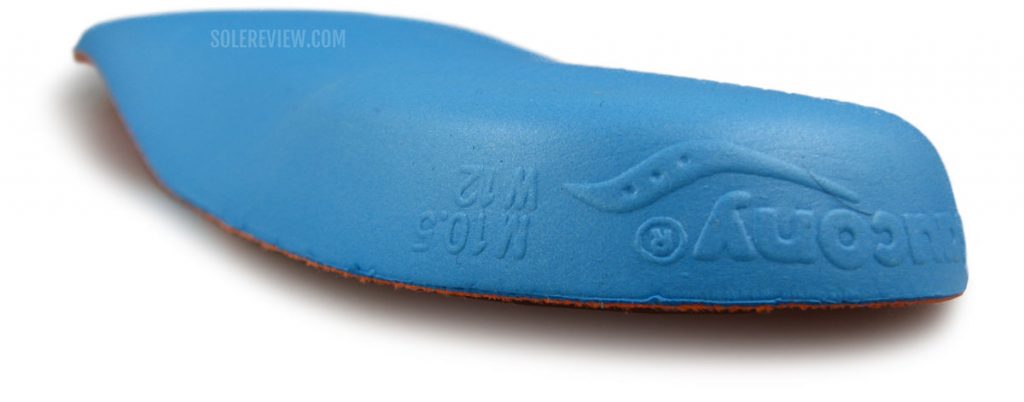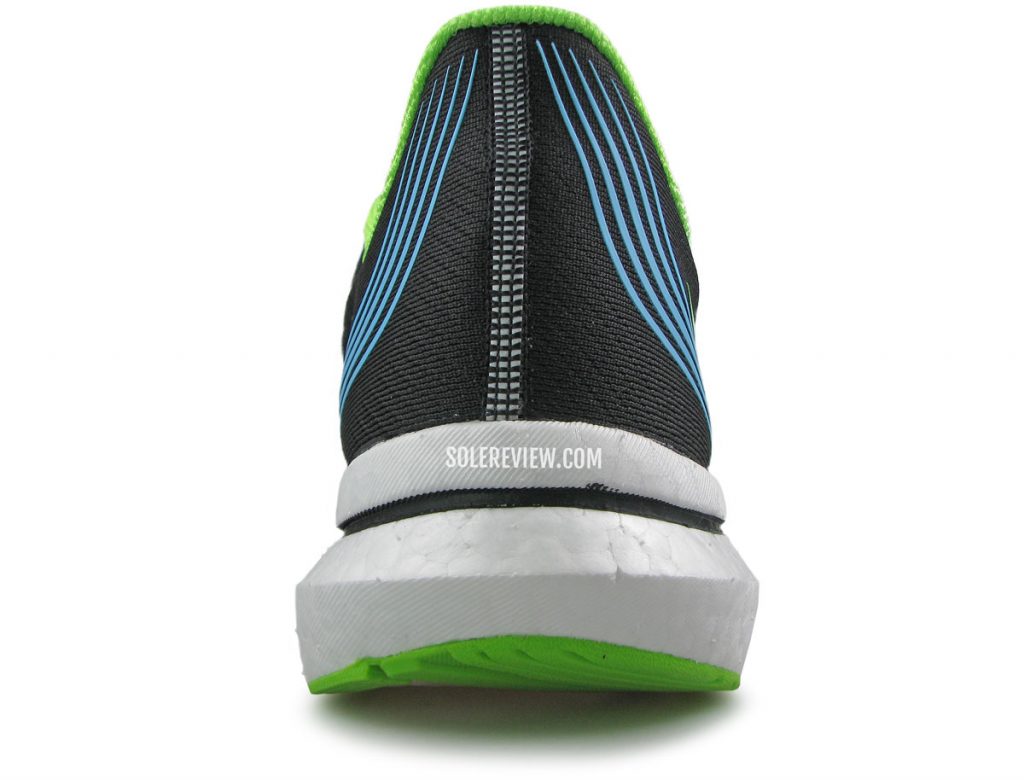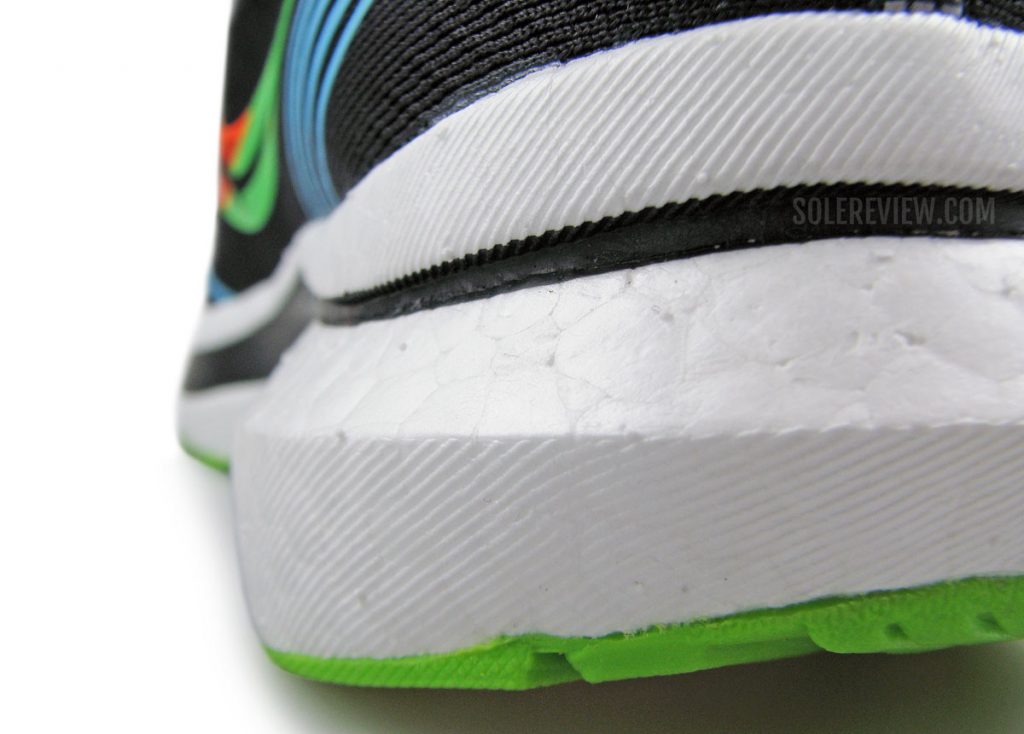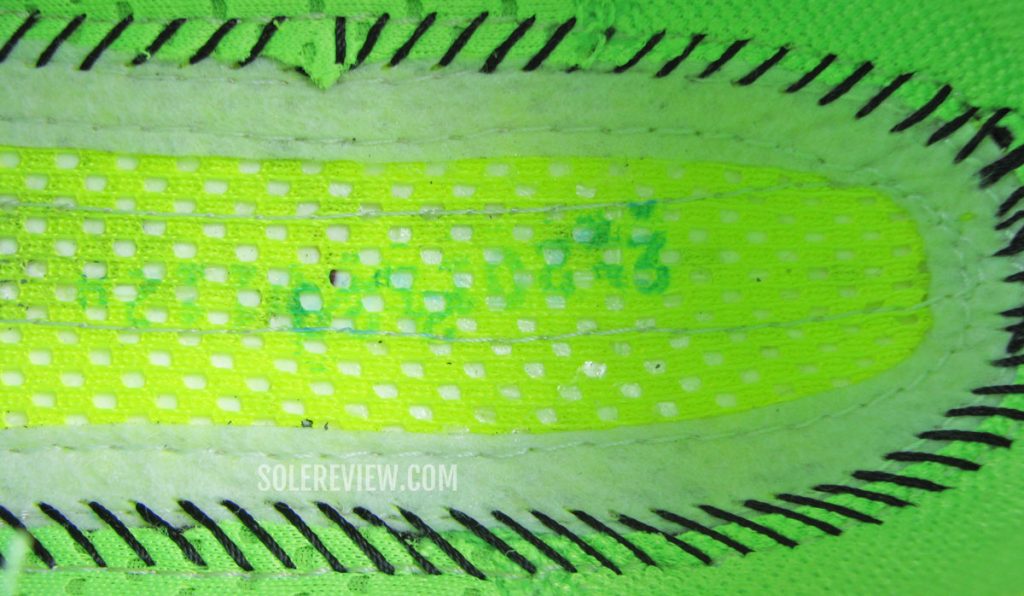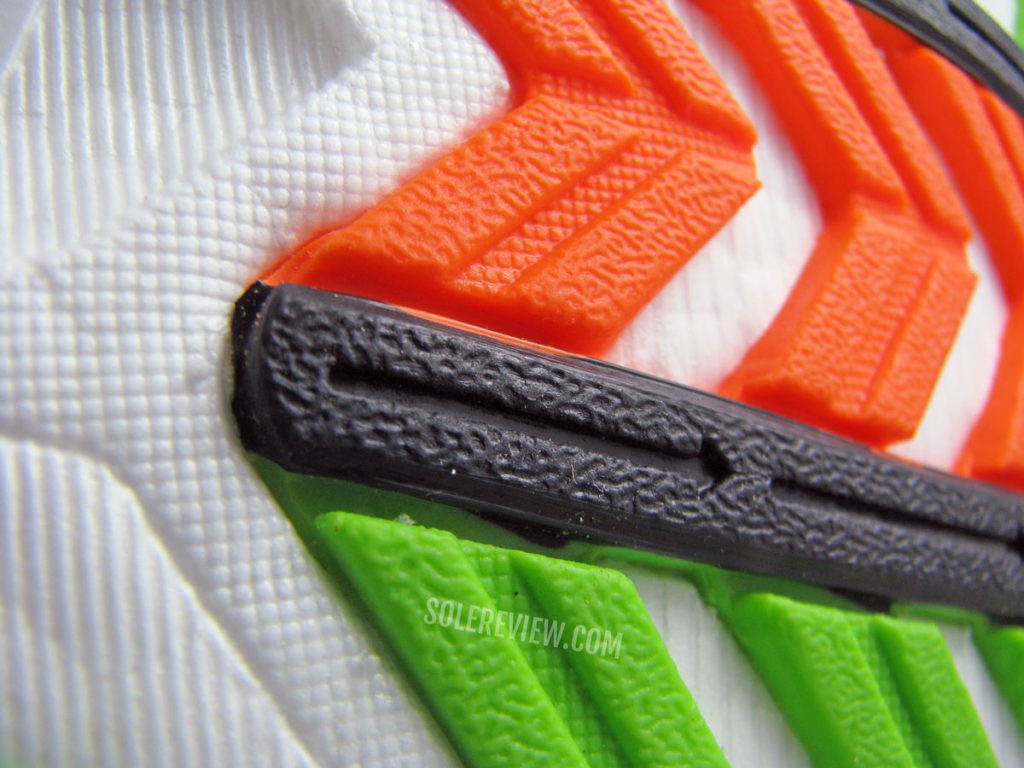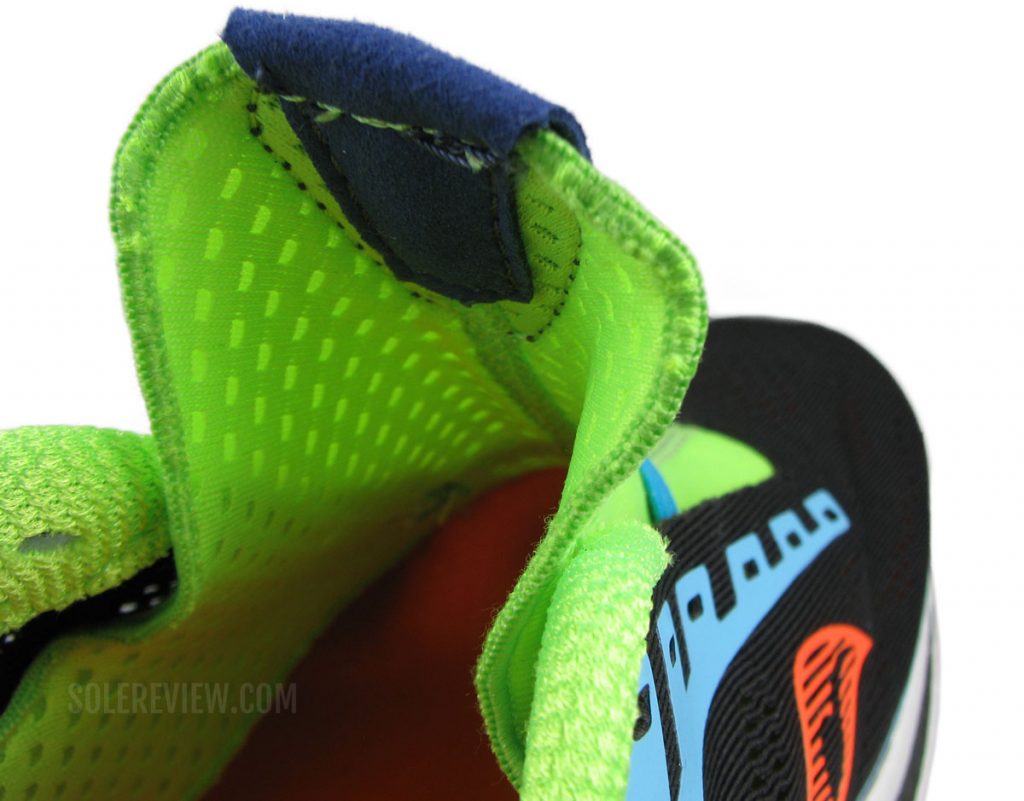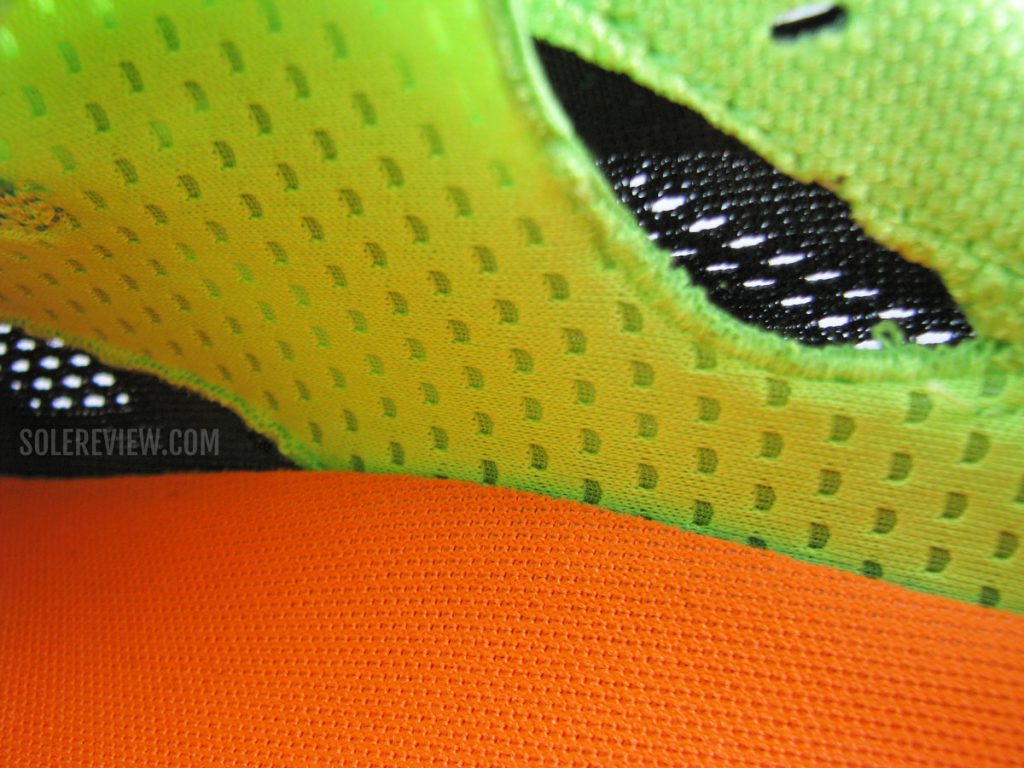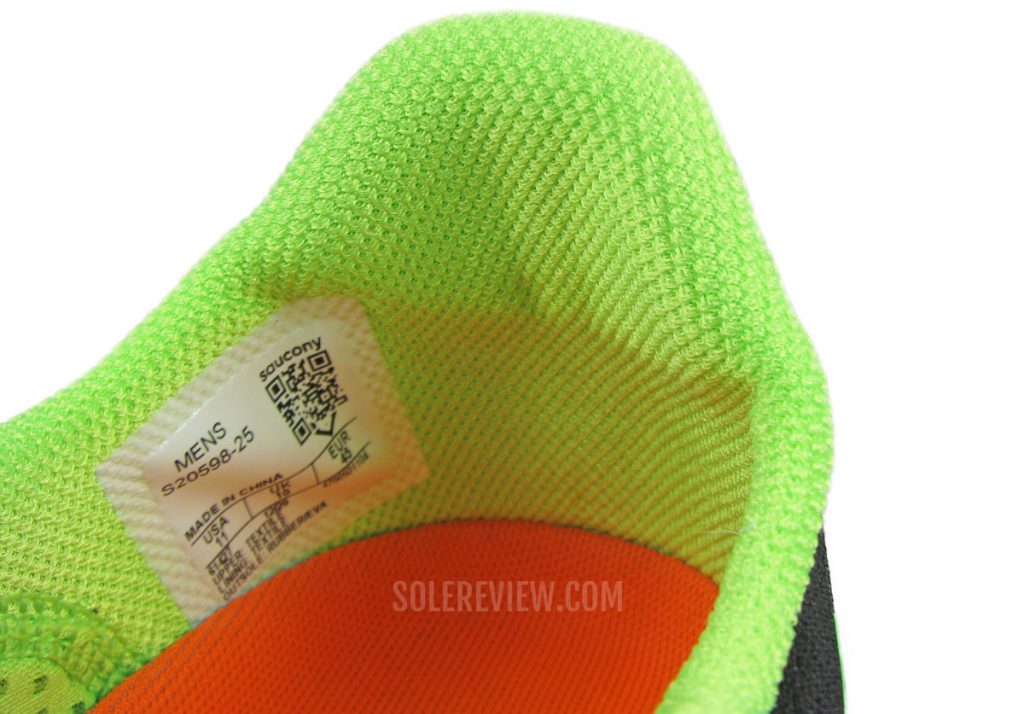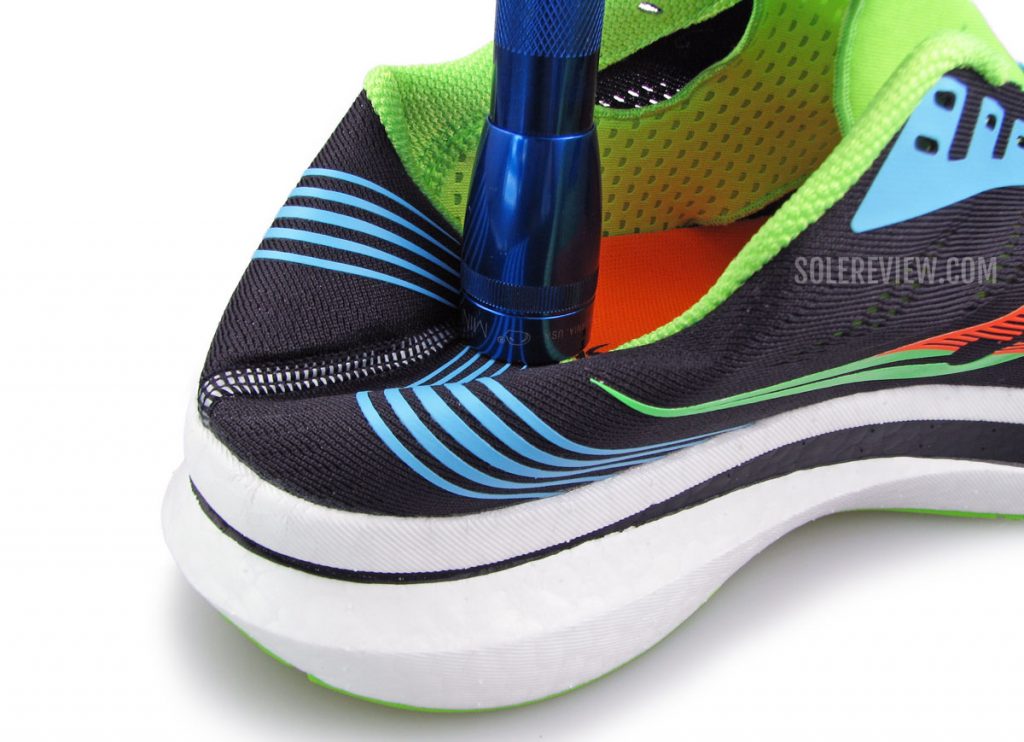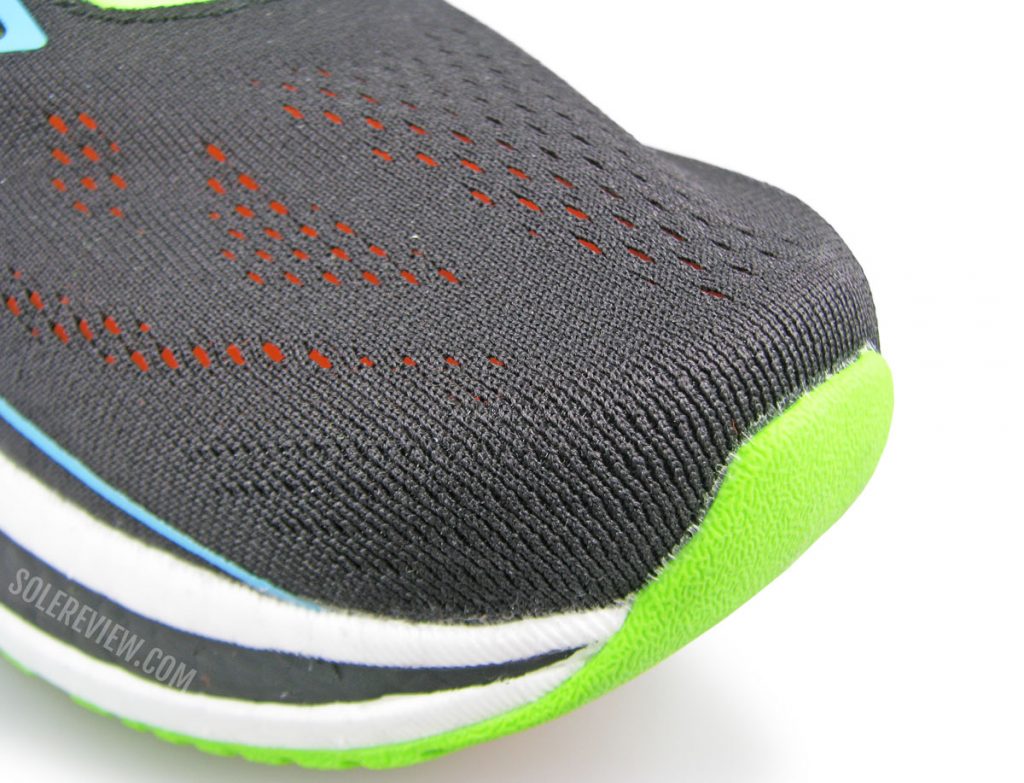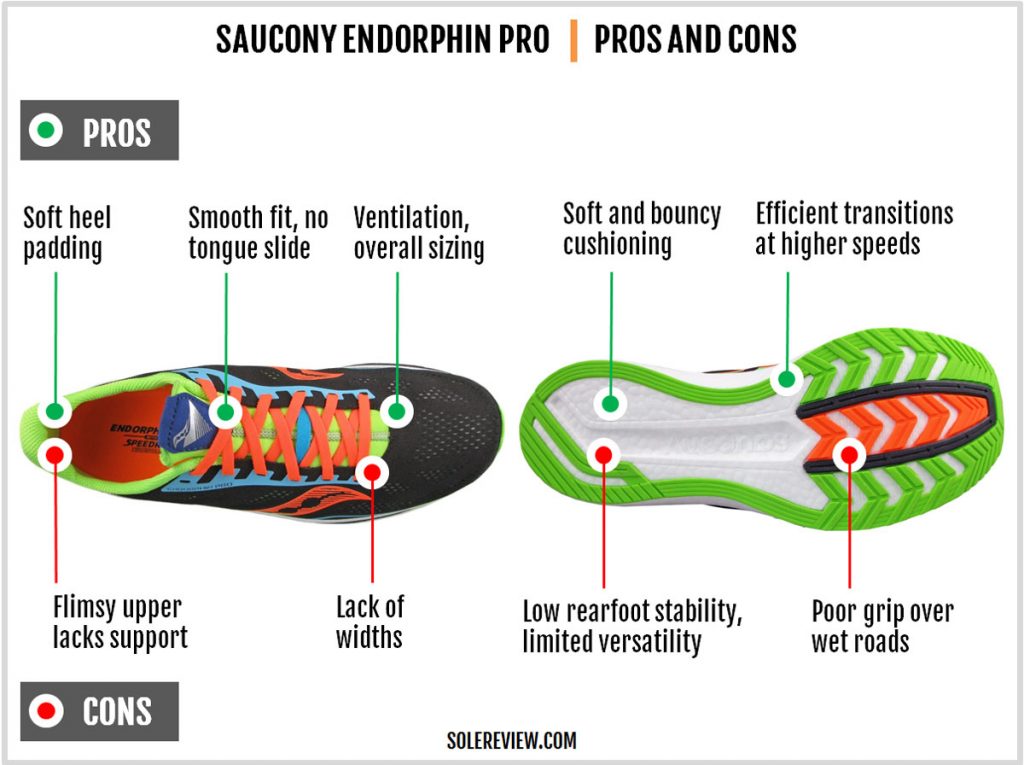INTRODUCTION
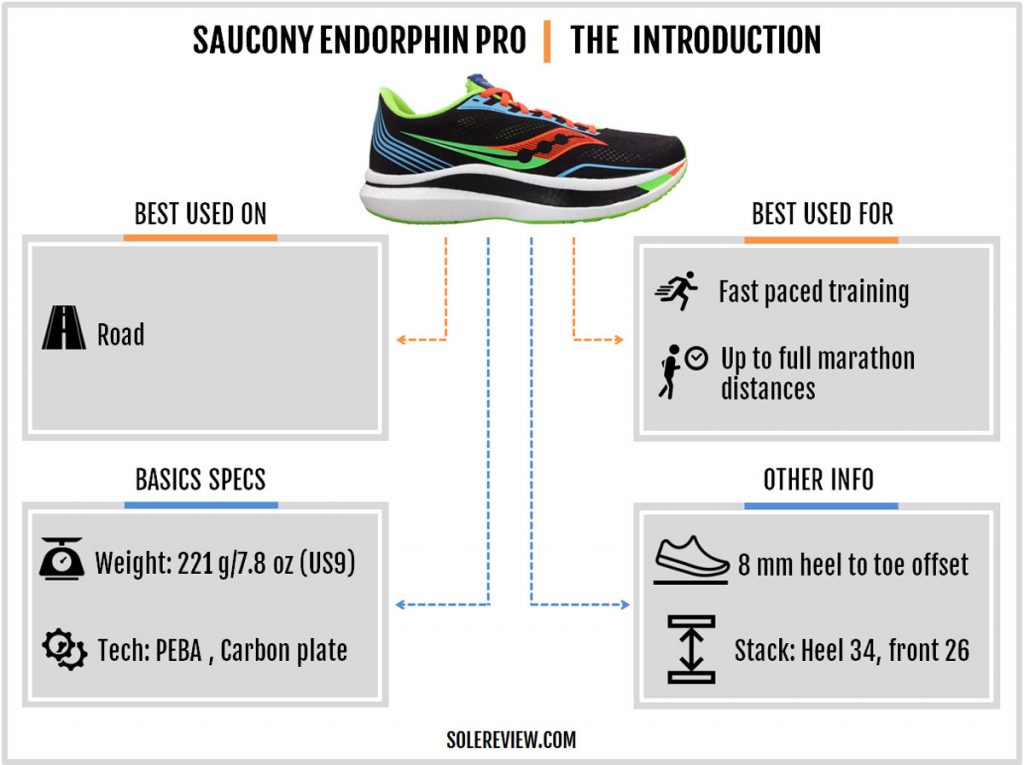
This is a review of the previous-generation Saucony Endorphin Pro, and not the V2 that has just come to the market. But there’s not a lot of difference between the two versions; since both share an identical midsole and outsole, getting the V1 for cheap makes better financial sense.
The Endorphin Pro is Saucony’s first stab at creating a Carbon-plated shoe, and the results are mostly impressive. Like most recent Saucony introductions, there’s clearly a lot of design thinking that’s gone into the creation of the Endorphin Pro. That also applies to the Nylon-plated Endorphin Speed, a shoe that we reviewed earlier this month.
We weren’t that impressed by the Endorphin Shift. Not because it’s an inferior shoe; it does many things rather well. It just doesn’t fit into the Speed and Pro’s ‘Speedroll’ storyline. Here’s our review, if you’re curious to know what that shoe is about.
Both the Endorphin Pro and Speed are excellent running shoes for long-distance training and races. Between the two, we prefer the less expensive Speed due to its (more) supportive upper and smoother plate-foam integration.
Saucony’s version of PEBA – namely the Pwrrun PB – has better resilience or tightness over comparable cushioning tech like Nike ZoomX or Reebok Floatride.
This distinction is achieved by producing their lightweight midsoles the same way they did their Everun and Pwrrun+ midsoles – by fusing hundreds of individuals globules rather than molding a single block of foam.
Within this high-tech midsole resides a Carbon plate that behaves similarly to the Nike Vaporfly.
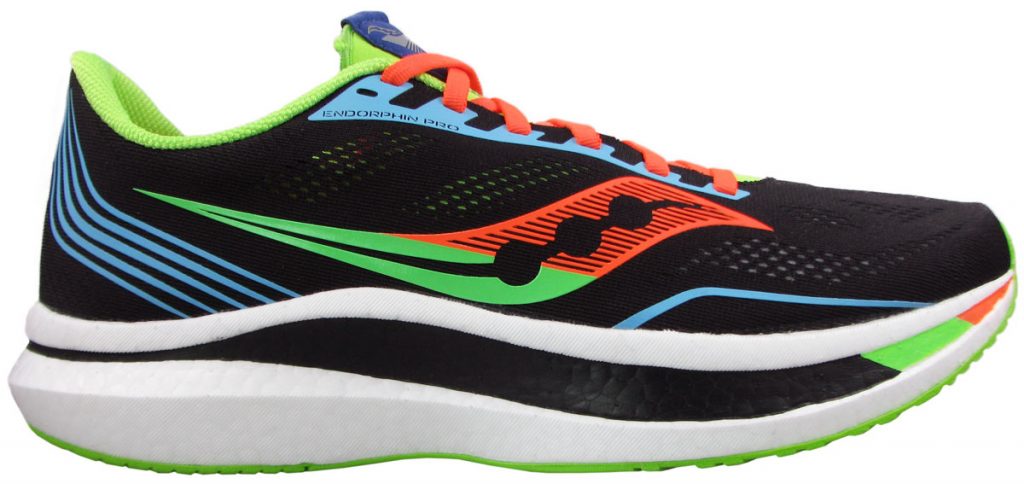
This is Saucony’s statement running shoe. A Carbon plate and PEBA midsole come as standard equipment.
The front is tethered to the base of the forefoot, and acts as a transition aid – or ‘Speedroll’ in Saucony-speak.
The rear part of the plate is suspended within the cushy core, and that’s how the familiar snap is delivered. The design isn’t novel, as Nike has done it before. However, Saucony’s PEBA midsole design is a unique execution of an oft-repeated concept.
While the upper is excellent, it is lacking in support. The lack of rearfoot stability was evident on the E-Speed, and it’s magnified on the Pro due to the absence of a heel counter.
As long as the distance runs and races do not involve fast corners, the ride experience is immensely enjoyable, rewarding midfoot-landing runners who push harder. The deep cushioning produces a cliched ‘energy return’ experience that keeps the feet fresh over an extended period.
It’s not versatile, but then, Saucony never said it was.
Both the Saucony Endorphin Pro and Speed were designed for specific use-cases, and that’s where these shoes deliver their best performance.
THE RIDE EXPERIENCE
The Endorphin Speed’s midsole comprises a single-density PEBA foam, aka the Saucony Pwrrrun PB. The PB is a nice wordplay; though it’s a shortened form of PEBA, it also alludes to the personal bests that runners will likely set during the ownership period.
And a fast shoe it is. A lightweight build is a necessary and desirable trait of racing shoes; reducing the weight also lowers the distraction levels during races. At 7.5 ounces (213 grams), the E-Pro clears the 8-ounce threshold by a healthy margin.
One of the best things to come out of the new racing shoe era is the happy co-existence of high-mileage comfort and speed manners. During the heydays of traditional racing flats, loading up on cushioning softness often meant sacrificing speed, and vice versa.
That compromise is no longer necessary.
The unique combination of an internal plate and bouncy midsole foam delivers superior comfort during the long haul, but without any slowness. The plate adds a snappy pep to the ride – be it the spring-type configuration seen on the Endorphin or the ‘roll forward’ kind on the Asics Metaracer or Hoka Carbon X2.
Here, the midsole has a full-length Carbon fiber plate that behaves like a spring in the rear and a rocker under the forefoot.
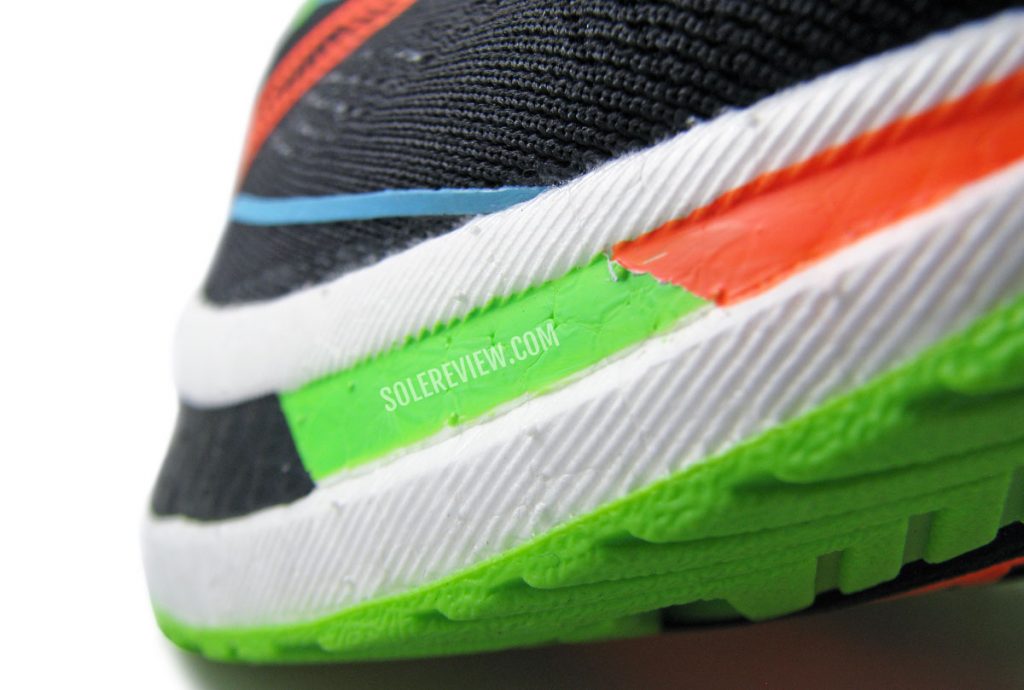
The stiff forefoot has a rocker profile. As a result, it favors quick roll-offs during the transitions.
Try to bend the shoe, and you’ll be met with a lot of resistance. That’s the plate doing its job. A stiff forefoot and a high toe spring make it a lot easier for the foot to roll forward – and that’s what Saucony means by ‘Speedroll’.
And what happens if the forefoot doesn’t have a plate? The recently tested Asics Hyper Speed is proof that you can run fast, but there will be a lot of footwork involved, old school style.
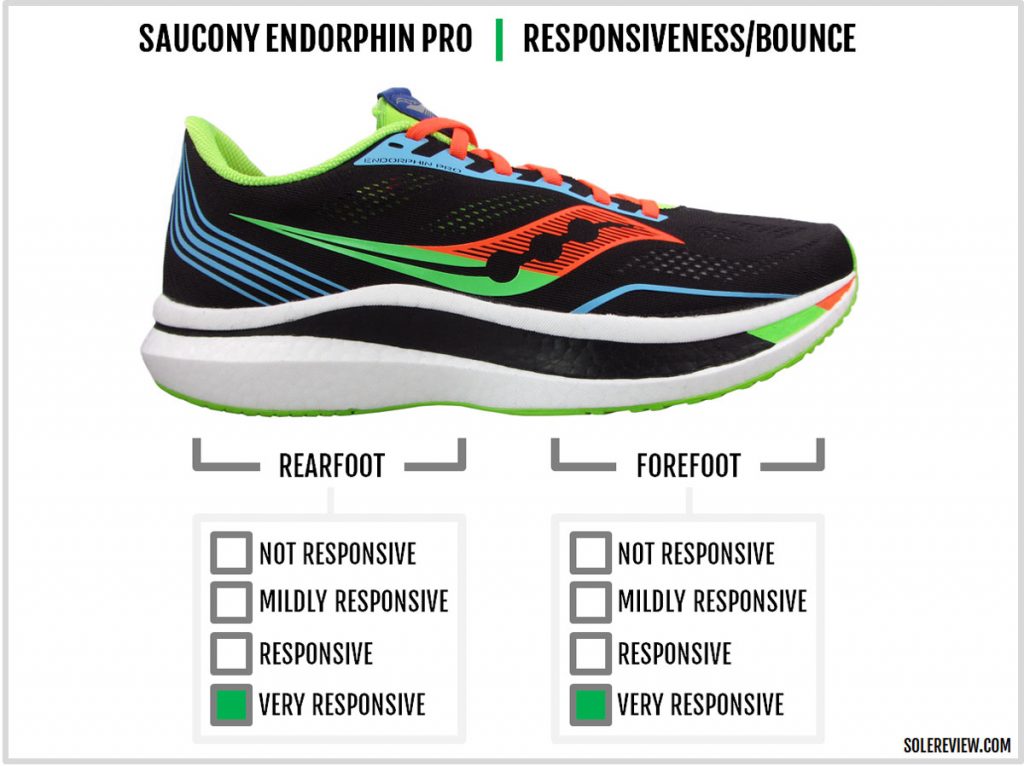
The suspended part of the Carbon plate adds a satisfying ‘push upwards’ sensation under the heel. The plate is isolated inside a cushy PEBA foam core, so that provides the freedom of movement needed to create the fulfilling rebound.
It won’t be wrong to say that the plate is the heart of the shoe, both on the Endorphin Speed and Pro. Without this component, neither would deliver the speed-friendly ride character we’ve come to know and appreciate.
Hypothetically speaking, if the Endorphin Pro’s midsole used a firmer material, the said snap would be taken down several notches. Just like the difference between the Nike Zoom Fly 3 and Vaporfly Next% 2.
Even with an Achilles-friendly offset of 8 mm, the forefoot and heel are stacked generously.
Going by Saucony specs, the forefoot and heel are 25.5 mm and 33.5 mm tall, respectively. This creates a cushioning landing and transition zone regardless of the foot-strike.
The plate’s full-length profile makes the transition-friendly benefits accessible across the entire midsole. A smooth, molded footbed resides atop the midsole for a layer of step-in softness.
One of the limitations of PEBA midsoles is the lack of rearfoot stability. In their current form, there’s an inherent lack of stability that results in decreased versatility. Unfortunately, the Endorphin Pro is also bound by that constraint.
Any athletic activity other than linear running on an even surface may lead to the foot roll. This is why the ‘recommended use’ on our introduction infographic omits trails and tracks. Treadmills are ok, but only just.
Similar to the Endorphin Speed, the bouncy heel isn’t much of a concern at high speeds – regardless of a rear or forefoot strike. During a quick touch and go, the foot doesn’t load long enough for the instability to kick in.
However, it’s a different matter at slower speeds. This is what robs both the Endorphin Pro and Speed of their versatility. The plate-loaded midsole works best at higher speeds (above 4:30 min/km or 7 min/mile) rather than easy paces. On easy runs, the heel is wobbly, and this is more pronounced on the more expensive Endorphin.
Here, it’s not just the midsole that plays a role; there are a couple of other variables thrown in.
On a traditional racing flat like the Saucony Type A9, the upper is minimal as possible to decrease weight and reduce the number of potential distractions. That approach works fine on a thin, flat sole with plenty of inherent stability. The PEBA-based Reebok Run Fast Pro illustrates our point perfectly.
However, the equation changes on a shoe with a tall PEBA midsole.
While Saucony makes a sincere attempt to boost the stability by incorporating flared sidewalls, the upper falls short. Unlike the E-Speed, the E-Pro lacks an internal heel counter.
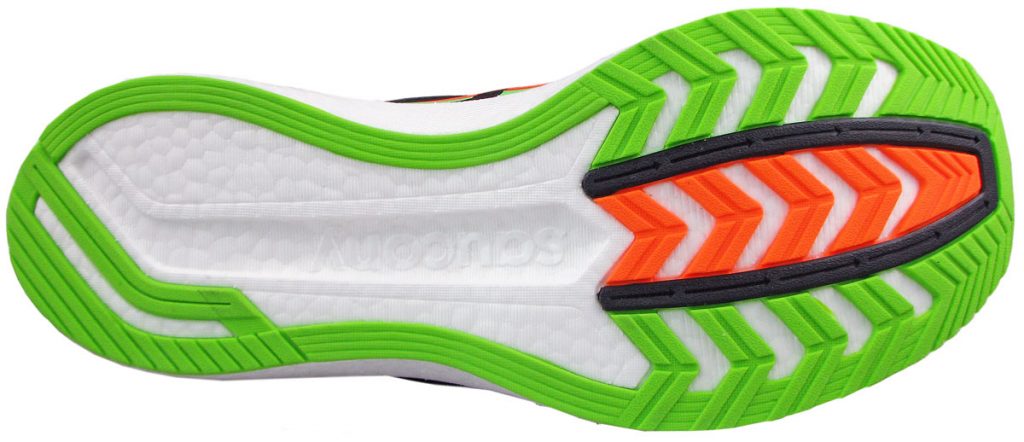
Most of the outsole rubber exists under the forefoot. The mid and rearfoot are softer due to the larger areas of exposed midsole foam.
As a result, the foot isn’t securely held over the midsole. Even on slightly uneven terrain, it feels as if the foot is going to slide right off.
Ankle roll is a real possibility if not careful. There’s not a lot of outsole under the rearfoot either – it’s just more PEBA foam. This, too, makes the heel soft and relatively unstructured.
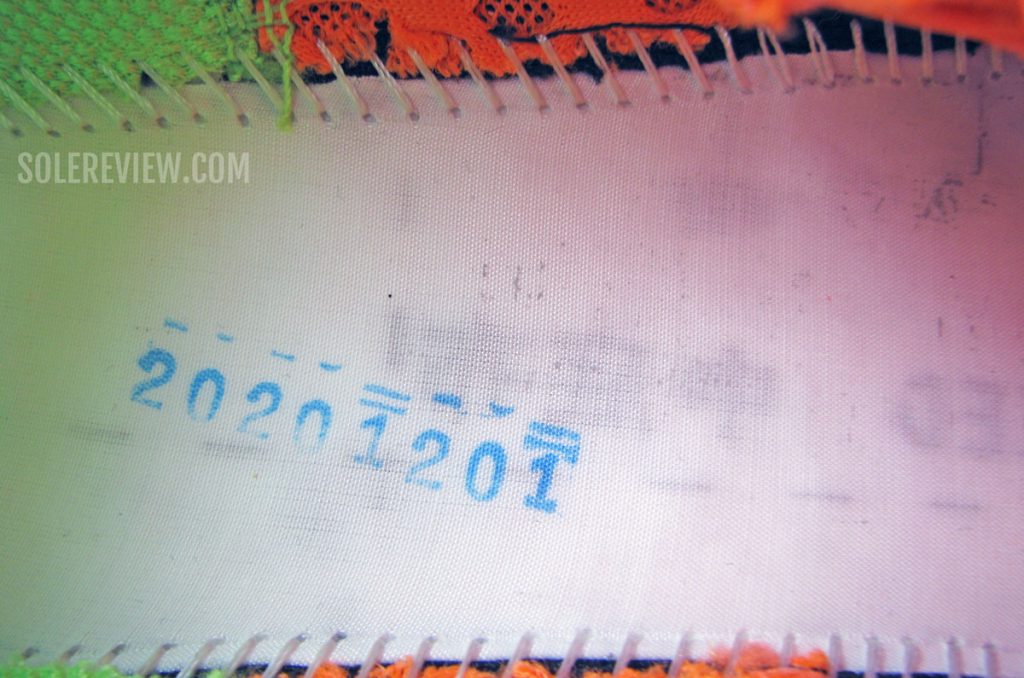
This is the fabric lasting of the less-expensive Endorphin Speed. We believe this overlooked component contributes to the ride stability and plate feel.
We believe that the lasting design also plays a part. To drive home our point, included above are the pictures of the lasting used on the Endorphin Pro and Speed.
The Pro has a mesh slip, whereas the Speed has a traditional fabric strobel. The latter adds a modicum of support when compared to the Endorphin Pro’s lasting that allows the foot to sink into the heel.
This is the reason why the stack heights of the Pro are a tad lower than the Speed, even with an identical sockliner. On a related note, the Endorphin trail is due for release in July. It will be interesting to see how Saucony addresses the stability issue.
We also suspect that the Pro’s see-thru lasting plays a role in isolating the snappy spring-back of the Carbon plate.
The outsole traction is poor on wet surfaces, so be careful when running over puddles. This is due to the smooth texture of the hard-wearing rubber.
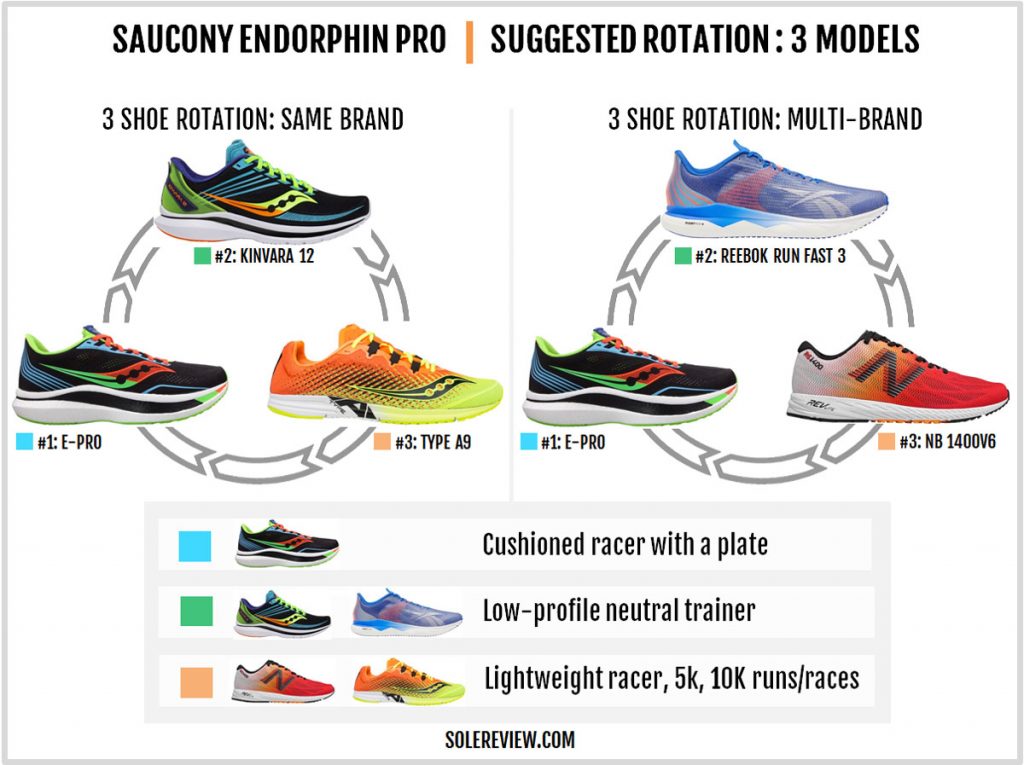
The Saucony Kinvara 12 would be the ideal daily trainer alongside the E-Pro. The upper is lightweight and comfortable, and the midsole combines a conventional EVA foam midsole with a smooth and supportive feel. The Saucony Ride 14 will also do well, if a firm neutral trainer is a rotational requirement.
The Reebok Floatride Energy 3 is a daily trainer option with more structure than the Kinvara. On the other hand, a shoe like the Reebok Run Fast 3 serves as a ‘faster’ version of the Kinvara.
We’d still prefer a traditional racing flat for blazing quick sprints or interval training on synthetic tracks because of the Endorphin Pro’s cushy heel.
Here, the Saucony Type A9 or New Balance 1400V6 are dependable and affordable options.
IS THE SAUCONY ENDORPHIN PRO DURABLE?
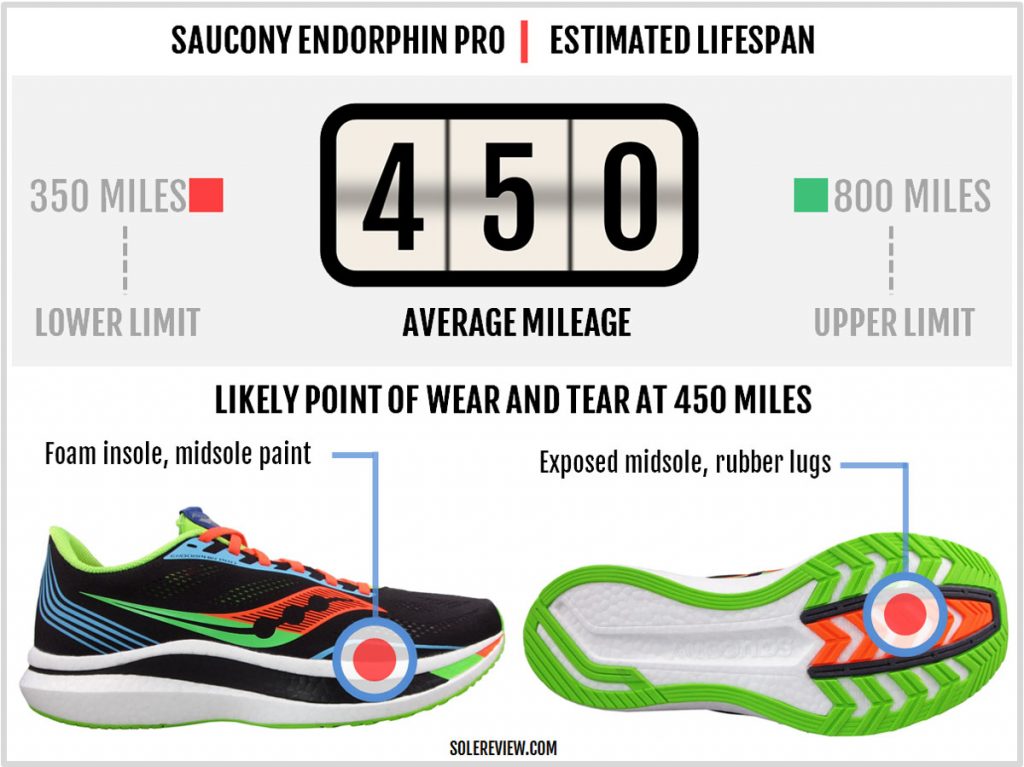
Though the upper has a very lightweight construction, we haven’t heard of any durability concerns. For now, we’ll assume the same benchmarks as the Endorphin Speed – which is a median lifespan of 450 miles.
The outsole is extremely durable due to the abrasion-resistant rubber. Saucony’s PEBA foam version is resistant to cushioning loss, and the fused foam globules do not crease.
THE UPPER DESIGN AND FIT
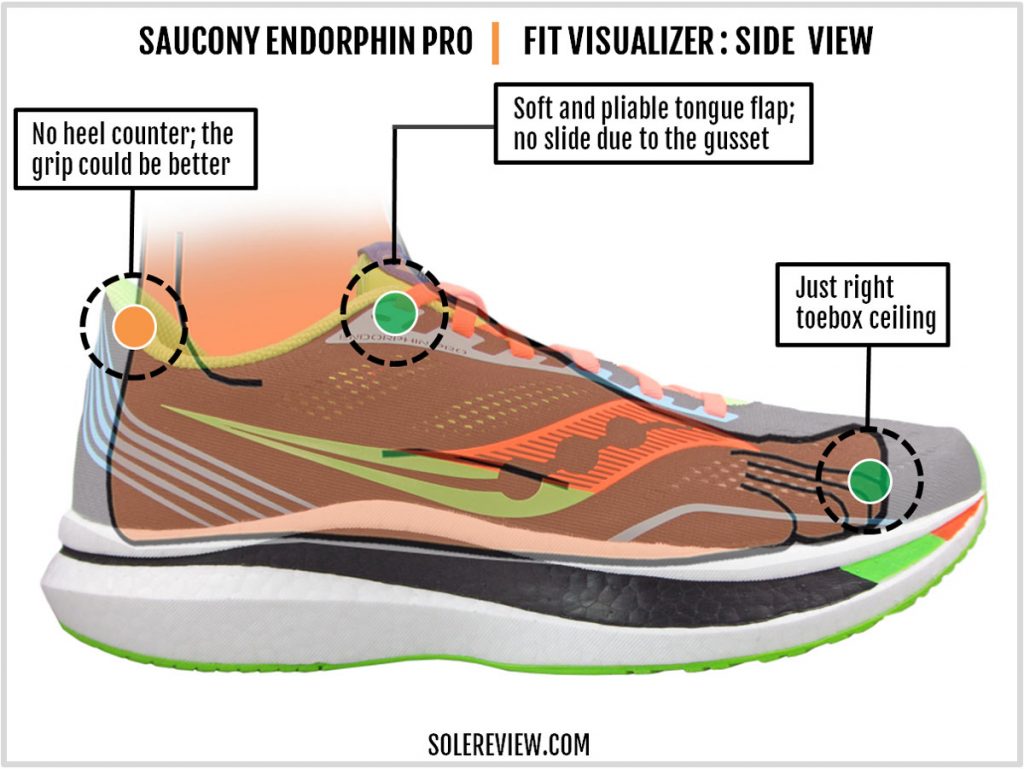
Saucony has been knocking it out of the park with the perfect interior proportions. In our book, that nets a lot of points for consistency.
Deserving of a mention is the fact that Saucony has stayed away from the prevailing industry trends like the flared heel lip, something that nearly all brands have fallen for.
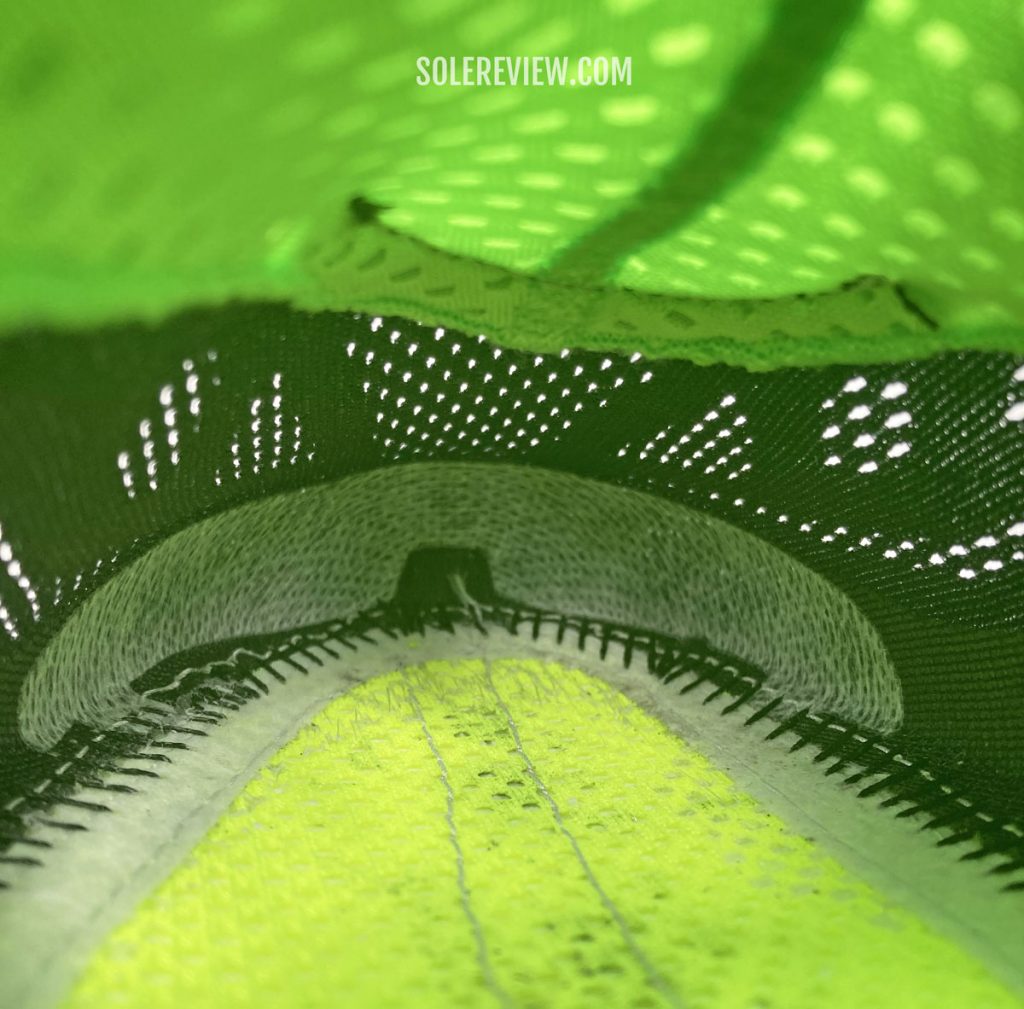
Here’s taking a look inside the toe-box. The ‘bumper’ is a thin piece of fabric fused to the mesh. The interiors are extremely breathable.
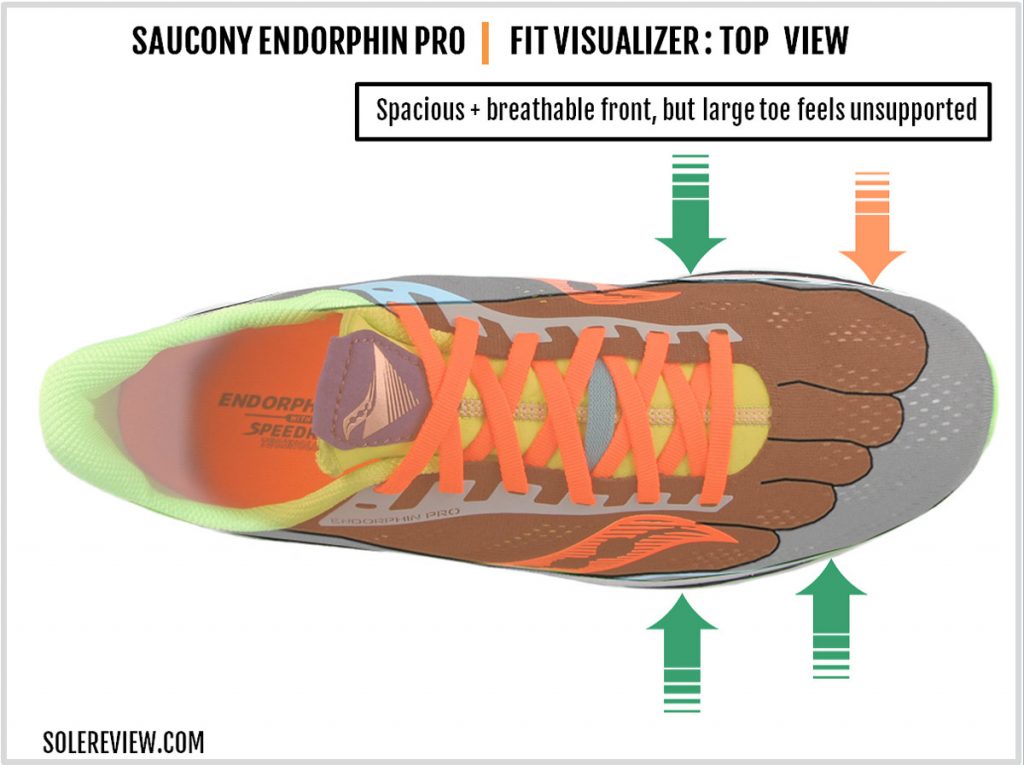
The space inside the entire Endorphin assortment feels just right.
The uppers fit true to size, the forefoot fit is accommodating, and the mesh exterior has a soft hand feel that allows the air to circulate freely.
There’s an internal toe bumper, but it’s just another piece of mesh bonded to the upper. The toe-box has a generous ceiling, so there’s a lot of space for the toes to spread wide.
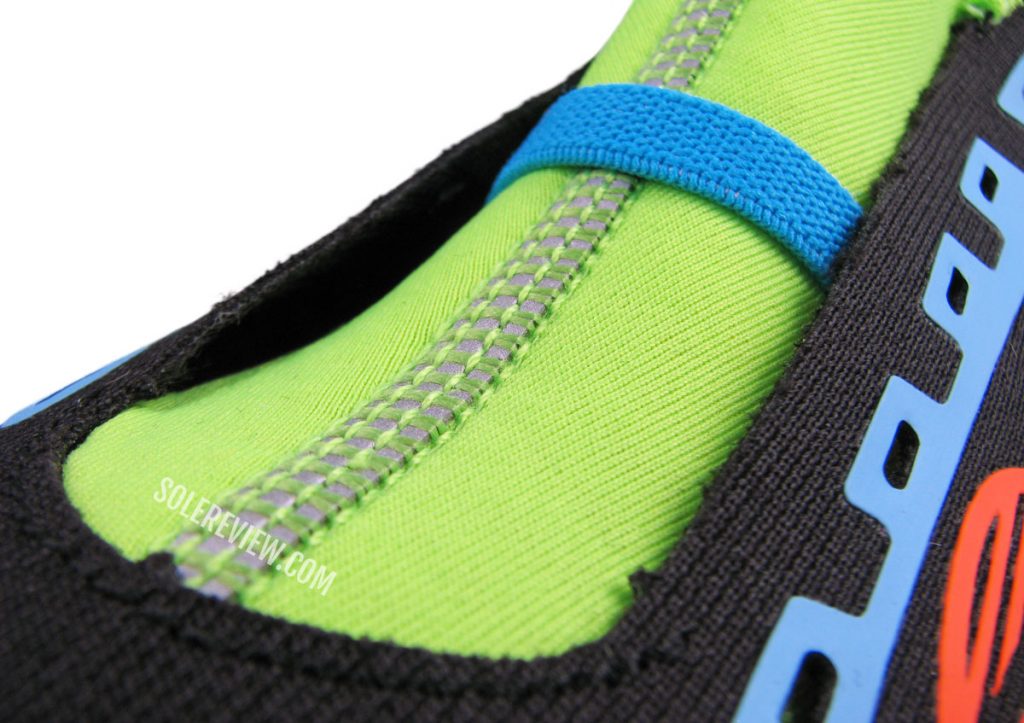
The elastic band (in blue) keeps the tongue flush with the foot. The strip running down the center is reflective.
The Endorphin Pro’s upper has a deconstructed feel to it, as evident in the lack of an internal heel counter and the minimal padding.
The tongue has no padding at all, and is merely an elastic component that also forms the gusset. A piece of elastic is attached over the tongue for a uniform stretch.
The laces are soft and elastic, so they do not create hot spots. The tongue length is a bit short, but is not detrimental to the fit experience.
Only the heel has some padding, and the lining material is very soft. As mentioned earlier, there’s no hard counter inside, thus making the heel completely collapsible. It is very gentle over the Achilles, so runners who usually find a hard counter over-bearing will find the soft heel very welcome.
On the flip side, the heel doesn’t feel locked in as it did on the Endorphin Speed. Without an internal counter, there exists a small gap between the foot and upper – a looseness of sorts. We did not find the heel fit to slip, but it does affect the ride stability underneath.
The same applies to the midfoot fit as well. The sleeved upper helps, but again, we think that the mesh lasting (under the insole) is probably making the fit a bit roomier when the feet loads on the midsole.
As a result, the midfoot doesn’t feel quite locked in on gradients, and tightening the laces only increases the top-down pressure without an even distribution of cinching pressure.
The Endorphin Pro V2 has a new upper, so we look forward to seeing what kind of functional updates are offered for 2021. Of noteworthy interest is the new arch band on the V2’s upper.
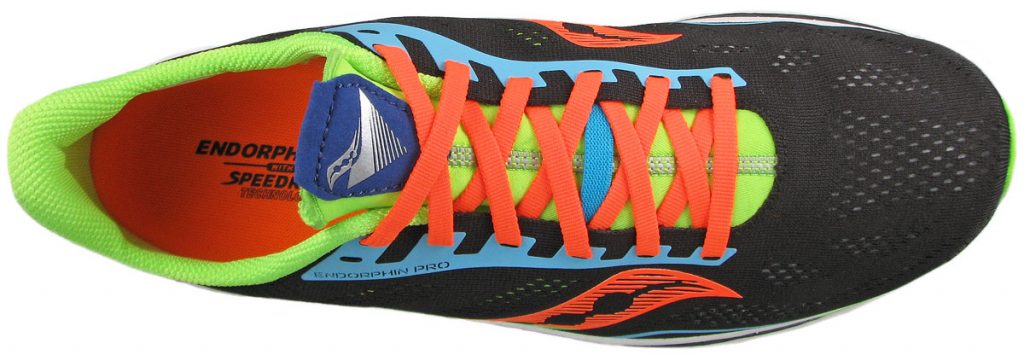
The breezy and distraction-free upper isn’t without its flaws. The midfoot grip isn’t great on downhill runs.
The extremely lightweight build of the toe-box has an unexpected consequence. The large toe feels unsupported on the side, and this becomes a bit obvious during downhills sections where the toe tends to ‘spill out’ a bit. The Endorphin Speed does not have this limitation due to its relatively robust build.
The reflectivity is distributed over the heel and tongue, so the shoe’s low-light visibility performance is satisfactory.
PROS AND CONS
The Endorphin Pro feels at home when it’s used as intended.
High-mileage speed runs are rewarding due to the generous amount of bouncy and speed-friendly cushioning. The plated design lives up to its ‘Speedroll’ marketing, as the transitions happen swiftly without the application of unnecessary exertion.
The cushioning keeps the feet fresh, whereas the well-ventilated upper cools the interiors during long-distance runs. While widths are not optional, the sizing profile is near-perfect, with excellent proportions length-wise and across.
Versatility isn’t the Endorphin Speed’s strongest suit, nor is its stability and outsole grip. The combination of the soft midsole and unstructured upper doesn’t yield the best outcome for stability, so we don’t recommend that the Endorphin Pro be used for easy runs, uneven trails, or races that involve tight corners – like a 200-meter synthetic track.
The outsole loses traction over wet roads, so be mindful.
THE SAUCONY ENDORPHIN PRO vs. ENDORPHIN SPEED
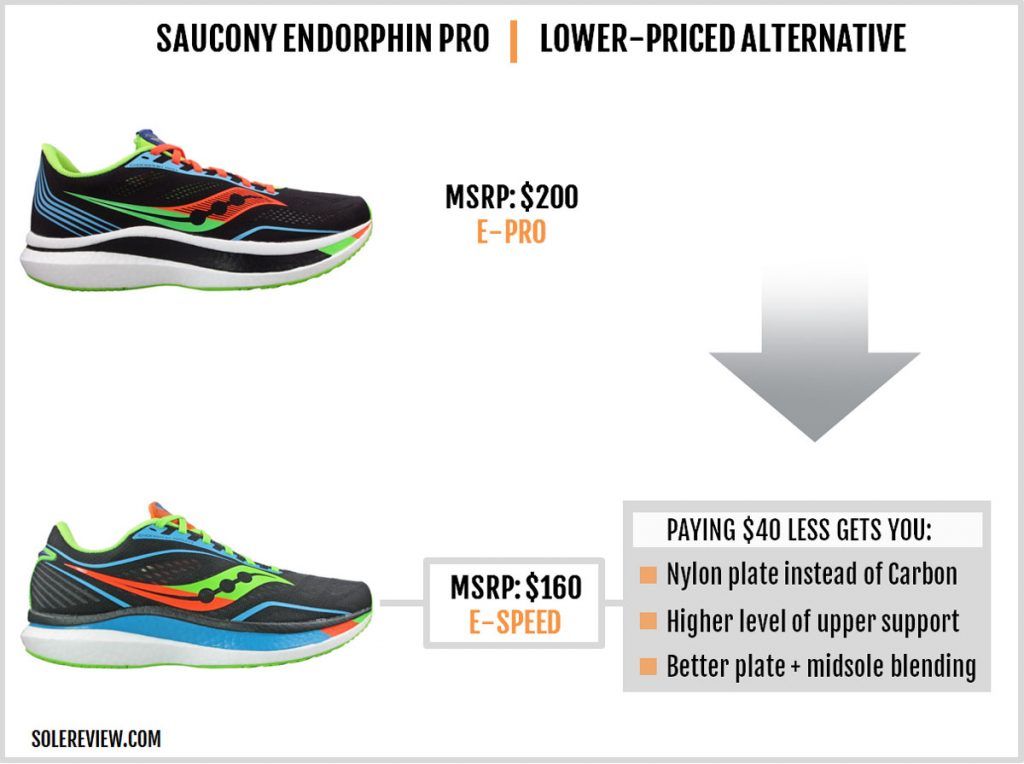
Discounting the obvious differences – like the Nylon plate versus the Carbon plate – it’s worth paying attention to what the Speed does differently on the road than the Pro.
While both models share an identical PEBA midsole core and outsole geometry, the Nylon plate of the less-expensive Endorphin feels better blended with the soft midsole.
On the Pro, the stiffer Carbon plate has a stronger snap that feels like a separate component rather than being an integral part of the midsole. It’s not a flaw; whether this is a like or dislike will be subjective.
The overall stability is superior on the Endorphin Speed due to its more supportive upper and lasting design. This is where we’d side with the Speed over the Pro – a supportive ride is desirable no matter what.
Owing to the lighter construction, the Pro is marginally lighter and better ventilated. However, the lower-priced Endorphin Speed makes a better case for itself.
SHOES SIMILAR TO THE SAUCONY ENDORPHIN PRO
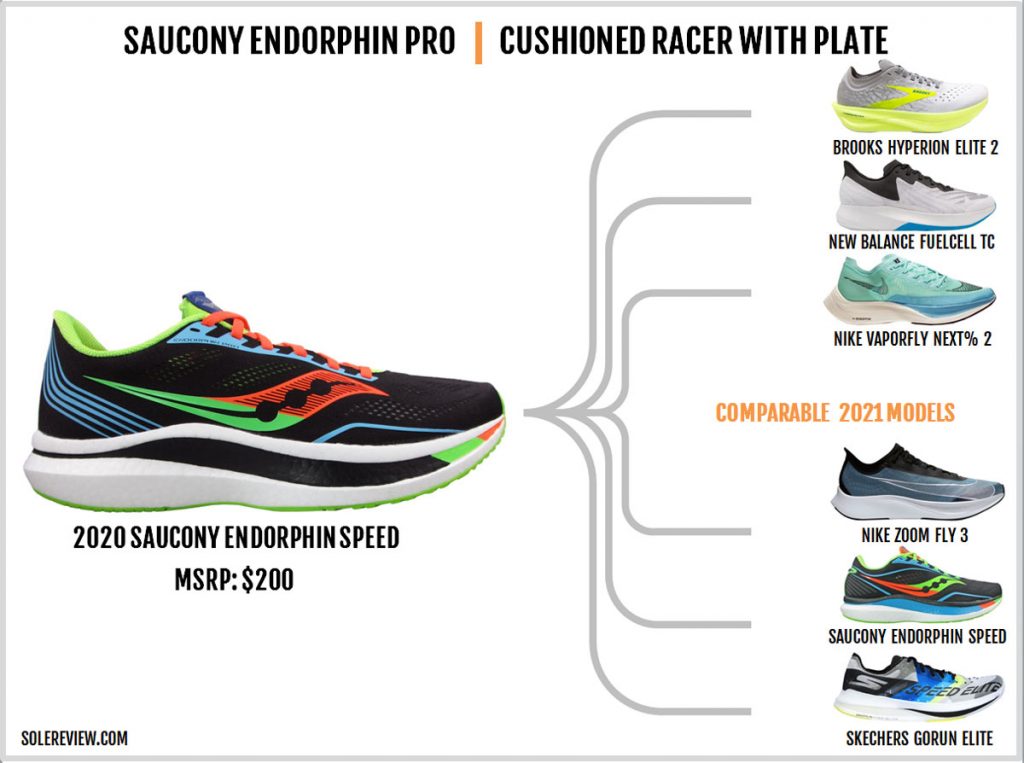
Owing to its innate similarities, the Endorphin Speed is the closest match to the Pro.
That’s followed by the Nike Vaporfly Next% 2, the patron god of all plated shoes; it has a softer PEBA foam-based shoe and a larger Carbon plate. The New Balance Fuelcell TC is also somewhat comparable, as it combines a very soft ride with an internal Carbon component.
For a firmer ride with better stability over the Endorphin, the Nike Zoom Fly 3’s Carbon-plated ride is a sensible alternative.
The Skechers GoRun Elite and Brooks Hyperion Elite 2 rely on Nitrogen and/or CO2-infused EVA foam midsoles, so the cushioning outcome differs from the softer PEBA foam midsoles. Their firmer ride is better suited for fast transitions without delivering the spring-loaded snap. Hoka and Asics shoes with midsole plates also fall into this category.
Do you own this shoe? Improve this review by sharing your insights – submit a review here.

